| Contents
Home
General
Info
Ordering
Info
Contact us
Cartridge
Lists
Patent & Miscellaneous
Rim Fire
Center Fire Pistol
Center Fire Rifle
Metric Rimfire,
Pistol&Rifle
British Pistol and Rifle
Shotgun Shells
Cartridge Boxes &
Related
Posters
This Month's Picture Page
Index to
Picture Pages
Prior Picture Pages:
*
September 2003
*
October 2003
*
November 2003
*
December 2003
*
January 2004
*
February 2004
*
March 2004
*
April 2004
*
May 2004
*
June 2004
*
July 2004
*
August 2004
*
September 2004
*
October 2004
*
November 2004
*
December
2004
*
January 2005
*
February
2005
*
March
2005
*
April
2005
*
May 2005
* June 2005
* July 2005
*
August 2005
*
September
2005
*
October 2005
*
November 2005
*
December 2005
*
January 2006
*
February 2006
*
March 2006
*
April 2006
*May 2006
*June 2006
*July 2006
*August
2006
*September
2006
*October
2006
*November
2006
*December
2006
*January
2007
*February
2007
*March
2007
*April
2007
*May
2007
*June
2007
*July
2007
*August
2007
*September
2007
*October
2007
*November
2007
*December
2007
*January
2008
*February
2008
*March
2008
*April
2008
*May
2008
*June
2008
*July
2008
*August
2008
*September
2008
*October
2008
*November
2008
*December
2008
*January
2009
*February
2009
*March
2009
*April
2009
*May
2009
*June
2009
*July
2009
*August
2009
*September
2009
*October
2009
*November
2009
*December
2009
*January
2010
*February
2010
*March
2010
*April
2010
*May
2010
*June
2010
Links to Other Sites
Cartridge Collectors Organizations:
IAA
ECRA
SAAACA
Auctions:
Auction
Arms
E-Bay
Ward's Collectibles
Sold USA
Books:
Armory
Publications
WCF Publications
Other Collector's Sites:
Curtis Steinhauer
|
Home of the Old Ammo Guy's Virtual
Cartridge Trading Table
Picture
Page
July
2010
Jabez H. Gill's reloading cartridge case....
A discussion on the IAA cartridge forum a couple of months ago centered
around Gill's replaceable anvil, which was tested at the Frankford Arsenal
in early 1877. While I had not heard of Gill's anvil before, I was familiar
with the name Gill in reference to U.S. military small arms ammunition
development. Jabez H. Gill started work at the Frankford Arsenal in 1864 as a
machinist, working his way up to foreman and then draftsman, and in 1881 he
was appointed as the arsenal armourer. He designed many of the cartridge
making machines that were used by the arsenal for fabricating and loading
the rifle and revolver cartridges that they produced. In 1879, he was issued a
patent for the primer that was used when the Benet inside-primed cartridge
case was phased out and replaced by an externally-primed reloading cartridge
case. In 1882, he patented a priming and de-priming tool that was standard
issue with the reloading tool sets produced from 1883 until sometime in the
early 1900s.
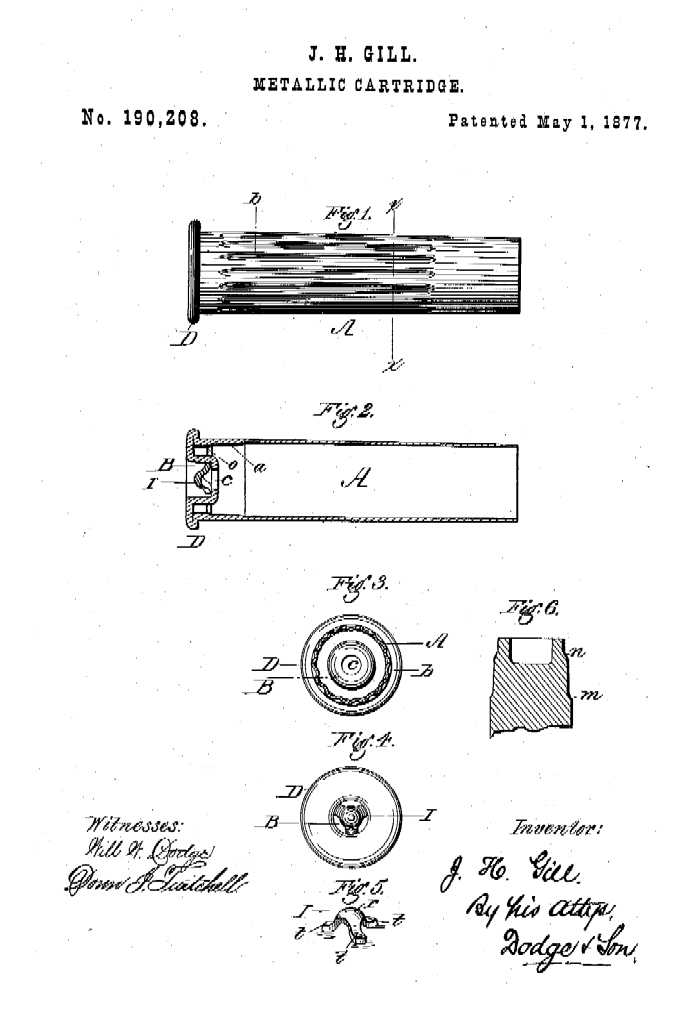 Gill
was granted patent 190208 for a re-loadable cartridge case that employed a
removable primer anvil on May 1st, 1877. The patent covered a copper
case with a thicker, stronger base and rim, and corrugations along its sides
to help prevent the case from expanding to the extent that it became jammed
in the rifle chamber upon firing. These improvements were intended to
address extraction problems that at the time were thought to have been partly
responsible for Custer's defeat a year earlier. Also covered by the patent
was the tool that was used to form the inside of the head of the cartridge case and,
almost as an afterthought, the three pronged anvil, about which he gave few
details in the patent specifications that accompanied his drawing. Gill's primer
anvil was not an integral
part of the primer pocket as was used on the Berdan case; instead, it was a
separate piece from the case, and could be easily removed and replaced if
necessary. The specifications are included below. Gill
was granted patent 190208 for a re-loadable cartridge case that employed a
removable primer anvil on May 1st, 1877. The patent covered a copper
case with a thicker, stronger base and rim, and corrugations along its sides
to help prevent the case from expanding to the extent that it became jammed
in the rifle chamber upon firing. These improvements were intended to
address extraction problems that at the time were thought to have been partly
responsible for Custer's defeat a year earlier. Also covered by the patent
was the tool that was used to form the inside of the head of the cartridge case and,
almost as an afterthought, the three pronged anvil, about which he gave few
details in the patent specifications that accompanied his drawing. Gill's primer
anvil was not an integral
part of the primer pocket as was used on the Berdan case; instead, it was a
separate piece from the case, and could be easily removed and replaced if
necessary. The specifications are included below.
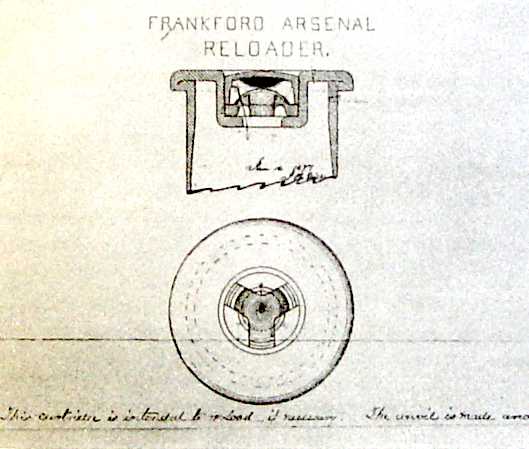 According to James Zupan,
author of Tools, Targets, and Troopers, on January 16th of 1877 Gill submitted
his design for a reloading cartridge case to Major James M. Whittemore, the
Commanding Officer of the Frankford Arsenal. Whittemore made notes on the
draftsman's print of the design, which said in part 'This cartridge is
intended to reload if necessary. The anvil is made and pressed in so as to
be practically permanent, and will last longer, for the work required of it,
than the case'. The draftsman's print, which is shown here, is from Mr.
Zupan's book. Major Whittemore recommended that 100,000 reloading cartridges
be produced for testing using Gill's case. According to an entry in a five
page handwritten Record of Alterations and Improvements in Rifle,
Carbine, and Revolver Ammunition, Cal. .45 prepared According to James Zupan,
author of Tools, Targets, and Troopers, on January 16th of 1877 Gill submitted
his design for a reloading cartridge case to Major James M. Whittemore, the
Commanding Officer of the Frankford Arsenal. Whittemore made notes on the
draftsman's print of the design, which said in part 'This cartridge is
intended to reload if necessary. The anvil is made and pressed in so as to
be practically permanent, and will last longer, for the work required of it,
than the case'. The draftsman's print, which is shown here, is from Mr.
Zupan's book. Major Whittemore recommended that 100,000 reloading cartridges
be produced for testing using Gill's case. According to an entry in a five
page handwritten Record of Alterations and Improvements in Rifle,
Carbine, and Revolver Ammunition, Cal. .45 prepared in 1878, which I received a copy of some years ago, production was begun on
March 14th, 1877. These cartridges had Berdan primers and were loaded with
405 grain bullets, the standard rifle bullet at that time. They were also some of the
first cartridges produced by the arsenal that had headstamps, as
in 1878, which I received a copy of some years ago, production was begun on
March 14th, 1877. These cartridges had Berdan primers and were loaded with
405 grain bullets, the standard rifle bullet at that time. They were also some of the
first cartridges produced by the arsenal that had headstamps, as
 headstamping
was commenced on March 22nd. The headstamps on the reloading cartridges were
R F 3 77 and R F 4 77. headstamping
was commenced on March 22nd. The headstamps on the reloading cartridges were
R F 3 77 and R F 4 77.
I have not been able to determine if the only cartridges produced
for testing at that time were the 100,000 using Gill's case with its
removable anvil, or if perhaps
other reloading designs were produced.
Unfortunately, the Report of the Chief of Ordnance for fiscal year 1877 does
not have a separate listing for re-loadable cartridges in its totals of small
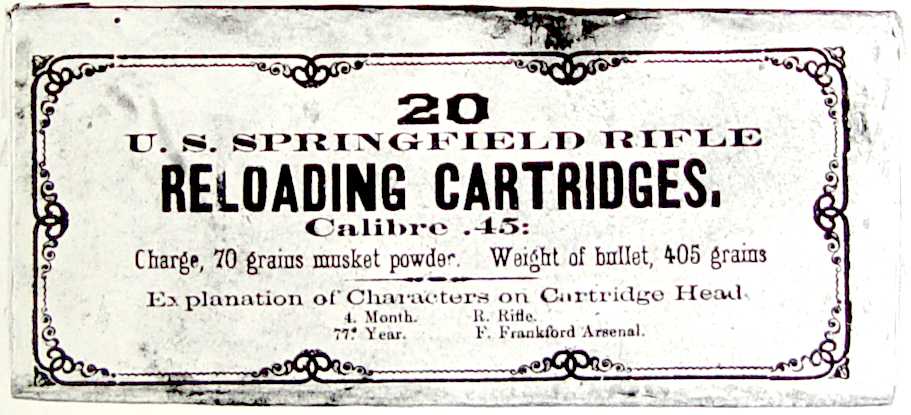 arms ammunition produced in that year, nor does it contain any reports that
address the testing of this ammunition. In addition, the labels on the
boxes of this ammunition provide no information regarding to the design of
the cartridge. The label shown above was copied from The .45-70
Springfield by Al Frasca & Robert Hill. arms ammunition produced in that year, nor does it contain any reports that
address the testing of this ammunition. In addition, the labels on the
boxes of this ammunition provide no information regarding to the design of
the cartridge. The label shown above was copied from The .45-70
Springfield by Al Frasca & Robert Hill.
Another draftsman's print from the Zupan book shows two primers that were used in developing the reloading
cartridge at the Frankford Arsenal. These primers are identified as 'J. H. Gill's Pat 1868 Frankford
Arsenal' on the left side of the print and 'Hobb's Patent Bridgeport' on the
right. I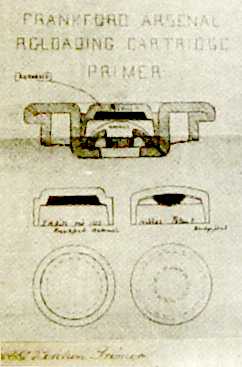 have not been able to locate an
1868 patent issued to Gill, but it would appear one benefit of his
primer design with its rebated edge would be to make de-capping of the case easier when
using one of the Berdan tools that pierces the primer cup with a sharp punch
in order to remove it. Otherwise, his primer appears to be of the Berdan style, consisting of the
open cup and a pellet of fulminate. I have never seen
this primer on any cartridge, much less a .45-70, so it is not likely that
it saw any use beyond developmental purposes. Notice that this same primer
using Gill's removable anvil is included in the sectioned case head shown at
the top of the drawing. The Hobb's patent that is referred to is most likely
A. C. Hobb's patent 94743, issued September 14th, 1869. It was an improvement
in the Berdan primer, and covered sandwiching the fulminate between two
layers of varnish to make it more water-proof. This primer is likely to be
the one that was primarily, if not exclusively, used on the R F
3 77 and R F 4 77 headstamped reloading cartridges. have not been able to locate an
1868 patent issued to Gill, but it would appear one benefit of his
primer design with its rebated edge would be to make de-capping of the case easier when
using one of the Berdan tools that pierces the primer cup with a sharp punch
in order to remove it. Otherwise, his primer appears to be of the Berdan style, consisting of the
open cup and a pellet of fulminate. I have never seen
this primer on any cartridge, much less a .45-70, so it is not likely that
it saw any use beyond developmental purposes. Notice that this same primer
using Gill's removable anvil is included in the sectioned case head shown at
the top of the drawing. The Hobb's patent that is referred to is most likely
A. C. Hobb's patent 94743, issued September 14th, 1869. It was an improvement
in the Berdan primer, and covered sandwiching the fulminate between two
layers of varnish to make it more water-proof. This primer is likely to be
the one that was primarily, if not exclusively, used on the R F
3 77 and R F 4 77 headstamped reloading cartridges.
It is possible that many, if not all, of the R F 4 77
headstamped re-loadable cartridges were fitted with Gill's replaceable
anvil. As I have only one of these cartridges in my collection, I am not
inclined to disassemble it to determine verify that it has the removable primer
anvil. I'd
love to see pictures showing the details of one of these cartridges that has
been sectioned if someone has one.
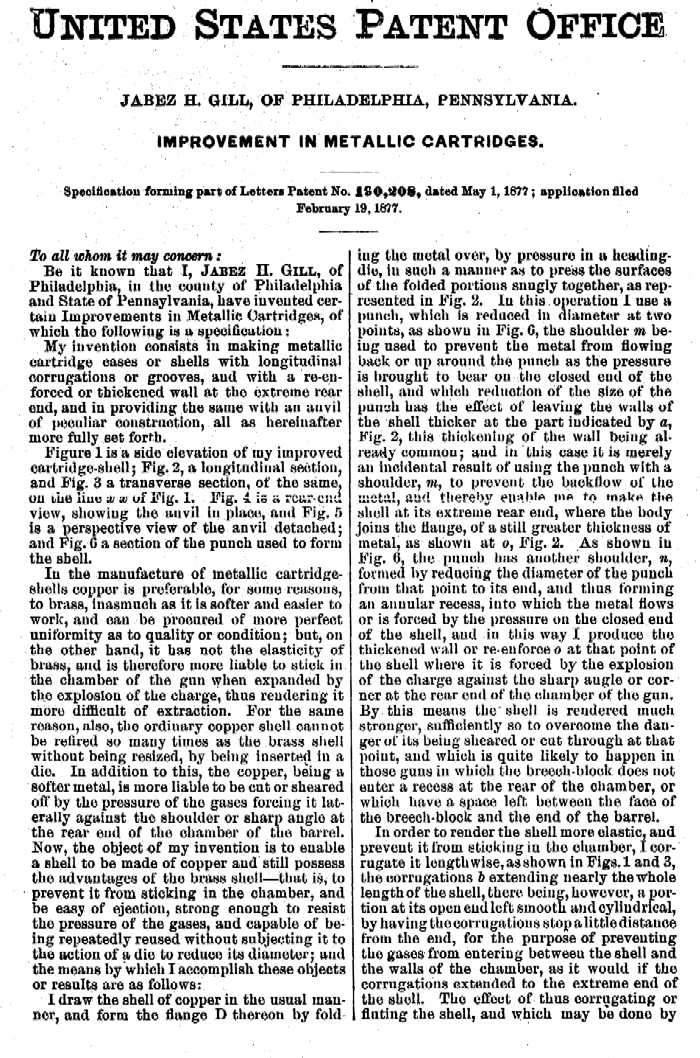
.
.
.
.
.
.
.
.
.
.
.
.
.
.
.
.
.
.
.
.
.
.
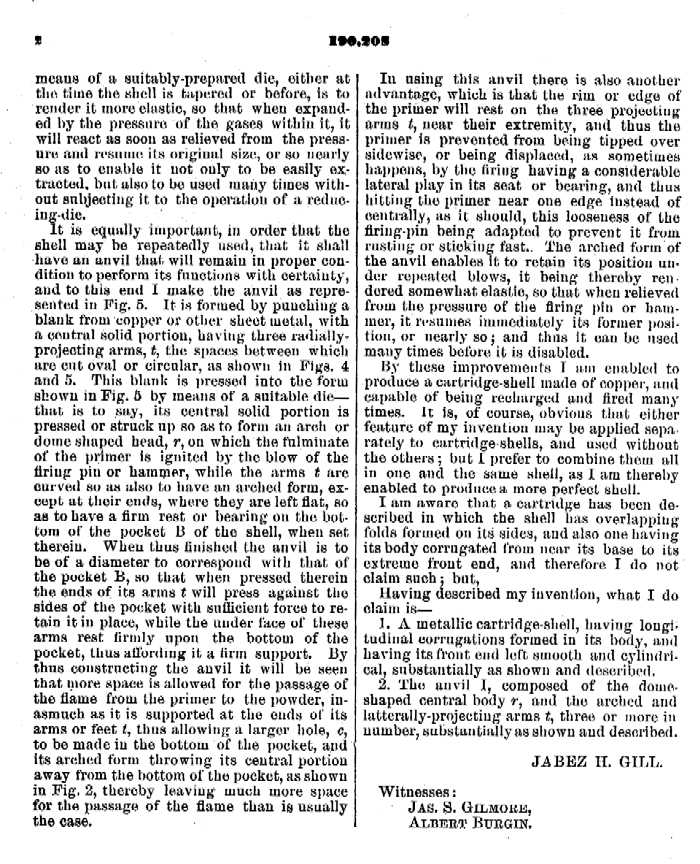
.
.
.
.
.
.
.
.
.
.
.
.
.
.
.
.
.
.
A well-used old Colt Model 1860
Revolver........
In spite of the fact that much of my attention is focused on old
ammunition, I like to think of myself as a fairly well-rounded individual,
with interests in other things as well; I like old guns, too. I
picked up the Colt Model 1860 revolver pictured below several months ago
from 'Honest' Ron Huskey, a friend of 30 or so years and a collector of Winchesters, Colts, and other things that go bang, although pocket
watches seem to be one of his latest interests. I have shared tables at our local
Tallahassee gun show with Ron for many of those years. As is often the case
at the Tallahassee show, not much happens from an antique gun and ammo
perspective, as nearly everyone attending the show tends to be interested in
new guns and ammo, and most of the sellers usually have their tables
filled with an assortment of the modern guns, ammo and accessories that this
mostly shooting crowd is looking for. Not so with Ron and me - we have
antique guns and related items on our tables, and that's all we generally
are looking for when we make our rounds checking out the other tables. As a
result, Ron, Ron's wife Barbara, and I tend to spend a lot of time at our tables,
which gives us plenty of time to talk and get caught up on what's been
happening in our lives over the prior few months since the prior gun show.
As is usually the case, by Sunday afternoon we are all talked out, and we
typically get down to wheeling and dealing for something that caught our eye
on the other fellows table. As is also usually the case, having not sold
enough to recoup our table and food expenses for the weekend, we tend to be
desperate for an infusion of cash, and therefore are not in the best frame
of mind to be on the selling end of one of these Sunday afternoon
transactions. The strategy as the potential buyer in one of these
Husky-Hildebrand deals is to not show any interest in the item that you have
taken a fancy to until Sunday afternoon, and to hope that the other fellow actually brings up the subject of a possible deal involving the
coveted item, as this indicates that he is really
anxious to sell. This is sometimes tough, as there is the slim chance that someone else will buy the item prior to Sunday
afternoon. Everything went as I had hoped for with the Colt revolver, although I
had a close call on Saturday when someone came close to buying it, but
eventually changed his mind when he noticed the trigger and a couple of
screws were missing.
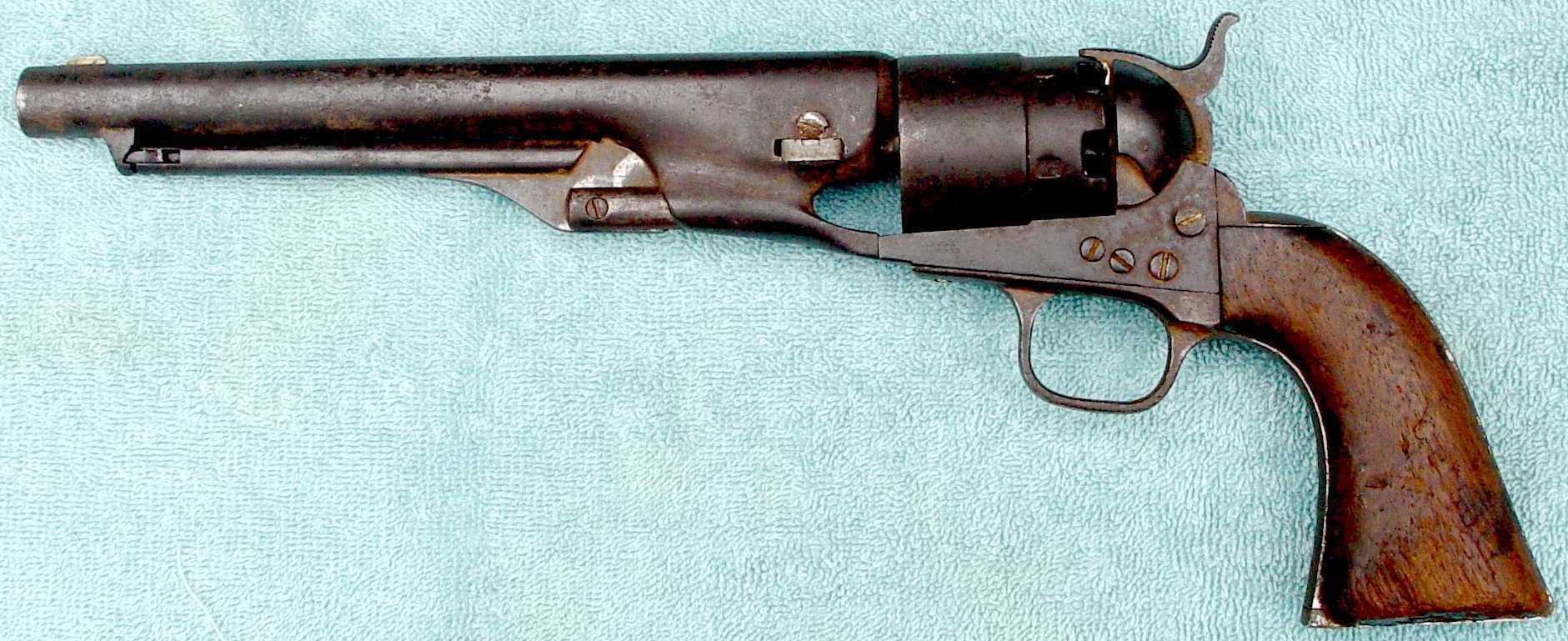 The
revolver didn't have much going for it. In addition to the missing trigger
and screws, it has mixed serial numbers, the barrel and cylinder were quite
loose, the head of the hammer screw had sheared off and had been epoxied
back in place, and the internal parts were worn out. What it did have in its
favor was that, aside from the glued in hammer screw head, the revolver
appeared to be in as-found, unmessed-with condition, sporting a consistent The
revolver didn't have much going for it. In addition to the missing trigger
and screws, it has mixed serial numbers, the barrel and cylinder were quite
loose, the head of the hammer screw had sheared off and had been epoxied
back in place, and the internal parts were worn out. What it did have in its
favor was that, aside from the glued in hammer screw head, the revolver
appeared to be in as-found, unmessed-with condition, sporting a consistent
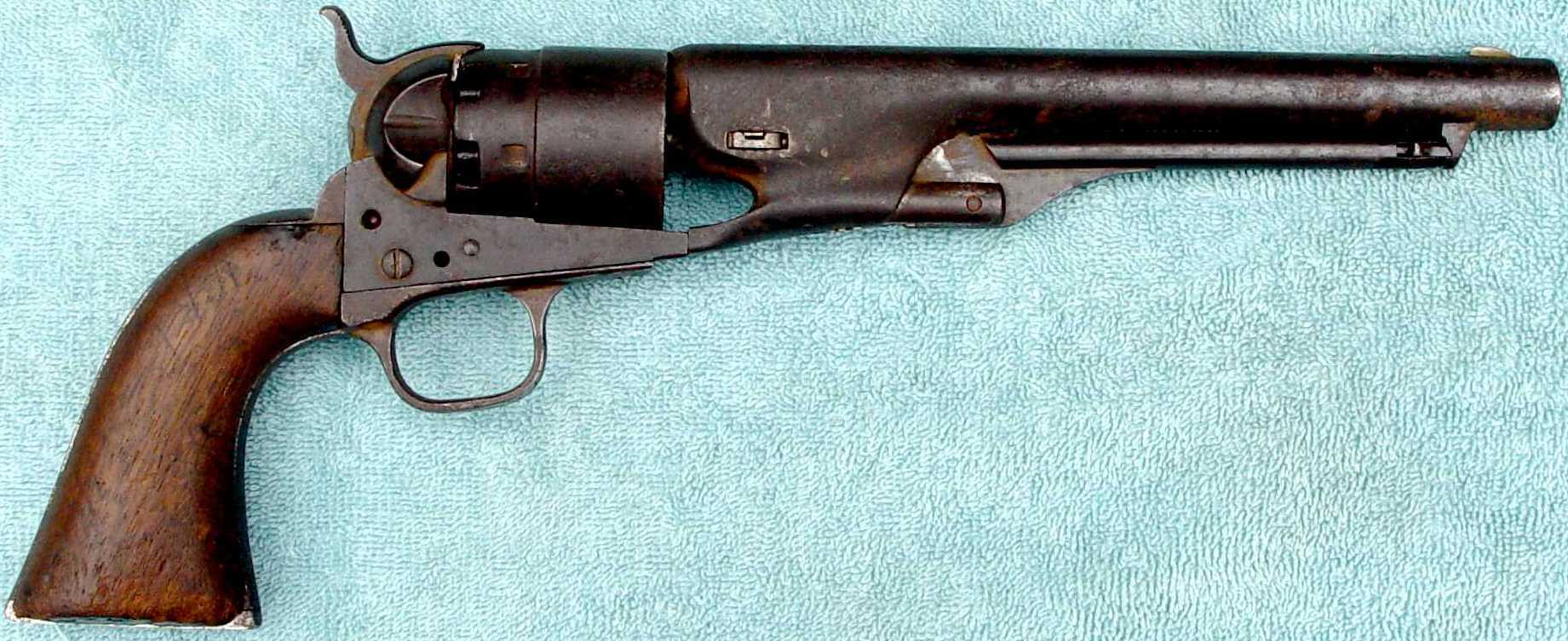 aged
brown finish on all of its surfaces and scattered patches of rust that
suggested that the parts that were there had been together for a long time;
furthermore, one chamber in the cylinder was still loaded. Also going for it
is the fact that the M1860 Colt, because of its graceful styling, is a
beautiful gun regardless of of what condition it is found in. aged
brown finish on all of its surfaces and scattered patches of rust that
suggested that the parts that were there had been together for a long time;
furthermore, one chamber in the cylinder was still loaded. Also going for it
is the fact that the M1860 Colt, because of its graceful styling, is a
beautiful gun regardless of of what condition it is found in.
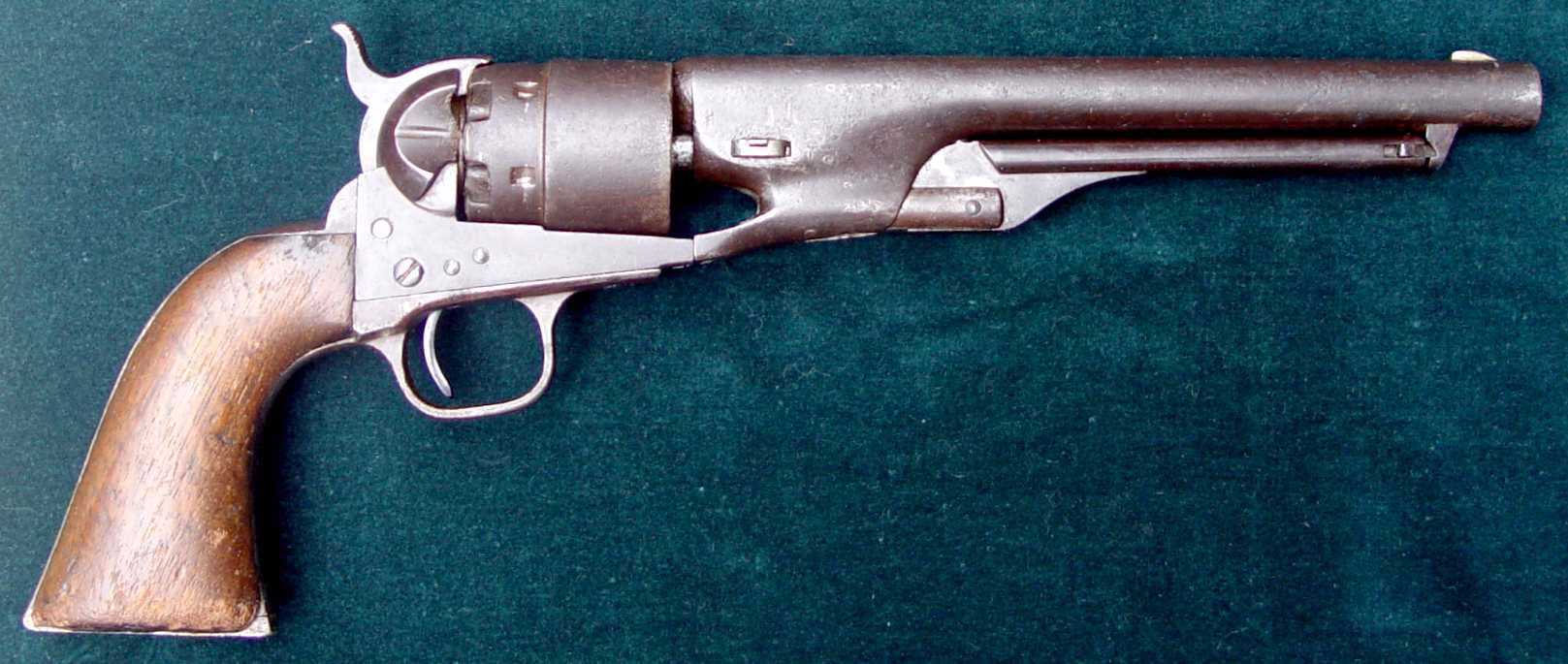
I
bought the revolver with the intention of doing only what work was required to
get it back to shooting
condition. In other words, I wanted the final product to look its age, and
to reflect the use and abuse that it had experienced over the years. After
six or seven hours of scraping with a piece of brass to remove the scattered
rust and clean out the assorted markings and tinkering to tighten up the
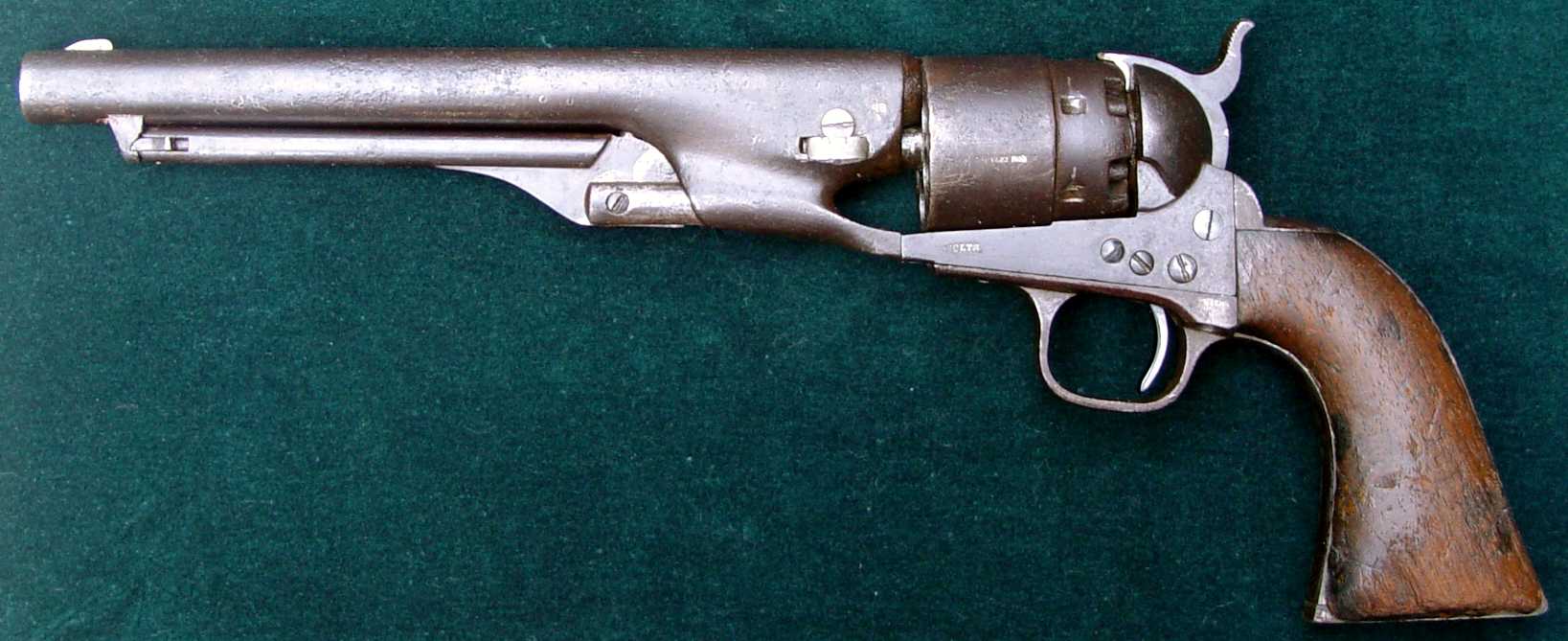 barrel and
cylinder, two orders to Dixie Gun Works for parts, and a little more time spent fitting the parts and adjusting the timing, the revolver turned out
pretty good. It looks its age and still has all the wear, dents, dings and
patina that it acquired over the last 150 or so years. Needless to say, I
wasted no time in test firing it, which fortunately went without a hitch. As
is apparent in the close-up pictures, the replacement screws and the trigger
are rather obvious, but I will eventually get around to making them look a
little less so without actually trying to hide the fact that they are not
original to the gun. barrel and
cylinder, two orders to Dixie Gun Works for parts, and a little more time spent fitting the parts and adjusting the timing, the revolver turned out
pretty good. It looks its age and still has all the wear, dents, dings and
patina that it acquired over the last 150 or so years. Needless to say, I
wasted no time in test firing it, which fortunately went without a hitch. As
is apparent in the close-up pictures, the replacement screws and the trigger
are rather obvious, but I will eventually get around to making them look a
little less so without actually trying to hide the fact that they are not
original to the gun.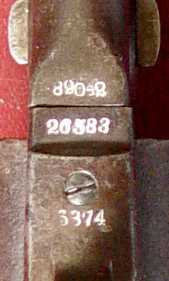 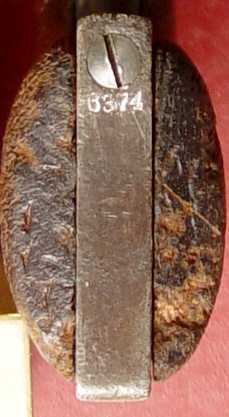
In the process of cleaning and repairing an old gun such as this, you
tend to get real familiar with it. Such was the case with this one. While it has mixed
serial numbers, all fall within the first four years of production. This
strikes me as a little odd. With production of the M1860 spread over twelve
years and numbering in excess of 200,000 revolvers, I would expect at least
one of the numbers to be over 100,000 unless the assorted parts were
assembled into a revolver in the early years of the model's production. The
trigger guard and back strap are numbered 6374, the frame is numbered 26582,
and the barrel is numbered 89042, indicating production in 1861, 1862 and
1863, respectively. There is no number visible on the cylinder or the wedge. The barrel appears to have
originally been on one of the approximately 130,000 U. S. military contract
revolvers, as it bears two inspection marks, a 'W' on the right side
 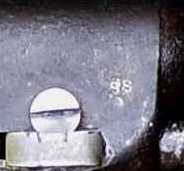 of
the lug and a 'SS' on the left side, as shown in the pictures on the left
and right. The other parts appear to have been
taken from civilian revolvers, as none has any markings that would indicate
that they went through the government inspection process. of
the lug and a 'SS' on the left side, as shown in the pictures on the left
and right. The other parts appear to have been
taken from civilian revolvers, as none has any markings that would indicate
that they went through the government inspection process.
The trigger guard is quite unusual, as it is made of steel rather than
the usual brass. Except for those revolvers made at Colt's London Armoury, I
am not aware of any other Model 1860 Colts revolvers having steel trigger
guards. The London Colts are typically in the 160,000 serial range or
higher, so it is not likely that this trigger guard is from one of them.
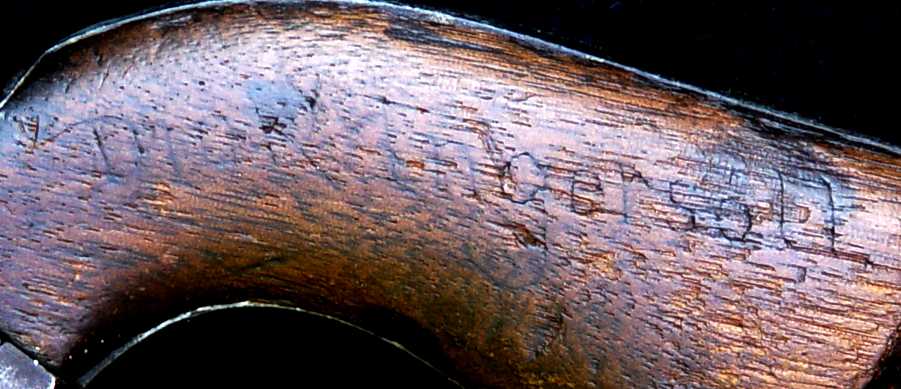 We
often hear someone make the statement 'If only it could talk' when looking
at an old firearm. While this particular revolver comes up short of actually
talking, it does provide a hint regarding its past. The
grips are well-worn, and have the name Dick Ingersoll cut into the left
side. I have no doubt that the grips are original to the grip frame based on the
condition of the screw that attached the bottom of the backstrap to the
trigger guard and the amount of work that was required to remove it. In
addition, the condition of the carving suggests that it was present through
most of the wear and tear that shows on the grips. An internet search yielded a George F. Ingersoll who went by the name
Dick. He was born in 1858 in Lynn, Massachusetts, moved as a child with his
family to Boone, Iowa in 1865, traveled with his father to the Black Hills
during the 1875 gold strike, was employed in 1878 as a cow hand by the
Lee-Scott Cattle Company of Fort Worth, Texas, was trail boss on cattle
drives of Lee-Scott steers from Texas to Eastern Montana beginning in
1884, and eventually settled on the Bow-Gun Ranch in the vicinity of Terry,
Montana. Perhaps George F. was the Dick Ingersoll who carved his name in the
grip of the revolver, perhaps as a youngster growing up in Iowa, or later in the
Black Hills gold diggings. We
often hear someone make the statement 'If only it could talk' when looking
at an old firearm. While this particular revolver comes up short of actually
talking, it does provide a hint regarding its past. The
grips are well-worn, and have the name Dick Ingersoll cut into the left
side. I have no doubt that the grips are original to the grip frame based on the
condition of the screw that attached the bottom of the backstrap to the
trigger guard and the amount of work that was required to remove it. In
addition, the condition of the carving suggests that it was present through
most of the wear and tear that shows on the grips. An internet search yielded a George F. Ingersoll who went by the name
Dick. He was born in 1858 in Lynn, Massachusetts, moved as a child with his
family to Boone, Iowa in 1865, traveled with his father to the Black Hills
during the 1875 gold strike, was employed in 1878 as a cow hand by the
Lee-Scott Cattle Company of Fort Worth, Texas, was trail boss on cattle
drives of Lee-Scott steers from Texas to Eastern Montana beginning in
1884, and eventually settled on the Bow-Gun Ranch in the vicinity of Terry,
Montana. Perhaps George F. was the Dick Ingersoll who carved his name in the
grip of the revolver, perhaps as a youngster growing up in Iowa, or later in the
Black Hills gold diggings.
.
.

|

 Gill
was granted patent 190208 for a re-loadable cartridge case that employed a
removable primer anvil on May 1st, 1877. The patent covered a copper
case with a thicker, stronger base and rim, and corrugations along its sides
to help prevent the case from expanding to the extent that it became jammed
in the rifle chamber upon firing. These improvements were intended to
address extraction problems that at the time were thought to have been partly
responsible for Custer's defeat a year earlier. Also covered by the patent
was the tool that was used to form the inside of the head of the cartridge case and,
almost as an afterthought, the three pronged anvil, about which he gave few
details in the patent specifications that accompanied his drawing. Gill's primer
anvil was not an integral
part of the primer pocket as was used on the Berdan case; instead, it was a
separate piece from the case, and could be easily removed and replaced if
necessary. The specifications are included below.
Gill
was granted patent 190208 for a re-loadable cartridge case that employed a
removable primer anvil on May 1st, 1877. The patent covered a copper
case with a thicker, stronger base and rim, and corrugations along its sides
to help prevent the case from expanding to the extent that it became jammed
in the rifle chamber upon firing. These improvements were intended to
address extraction problems that at the time were thought to have been partly
responsible for Custer's defeat a year earlier. Also covered by the patent
was the tool that was used to form the inside of the head of the cartridge case and,
almost as an afterthought, the three pronged anvil, about which he gave few
details in the patent specifications that accompanied his drawing. Gill's primer
anvil was not an integral
part of the primer pocket as was used on the Berdan case; instead, it was a
separate piece from the case, and could be easily removed and replaced if
necessary. The specifications are included below.  in 1878, which I received a copy of some years ago, production was begun on
March 14th, 1877. These cartridges had Berdan primers and were loaded with
405 grain bullets, the standard rifle bullet at that time. They were also some of the
first cartridges produced by the arsenal that had headstamps, as
in 1878, which I received a copy of some years ago, production was begun on
March 14th, 1877. These cartridges had Berdan primers and were loaded with
405 grain bullets, the standard rifle bullet at that time. They were also some of the
first cartridges produced by the arsenal that had headstamps, as

